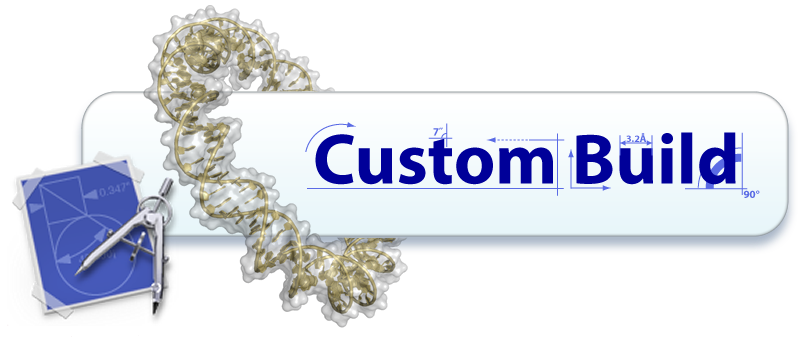 There is a growing interest in the structural study of DNA in
complex with a ligand or in their native form. Experimental techniques such as Nuclear Magnetic Resonance spectroscopy (NMR) and X-ray
crystallography as well as computational methods try to gain more insight into the structure and function of these molecules.
There is a growing interest in the structural study of DNA in
complex with a ligand or in their native form. Experimental techniques such as Nuclear Magnetic Resonance spectroscopy (NMR) and X-ray
crystallography as well as computational methods try to gain more insight into the structure and function of these molecules.- An important part in the pipeline of DNA structural studies is the generation of models. Often, 3D structural models of DNA are required, for instance, to serve as templates for homology modelling, as starting structures for macro-molecular docking or as a scaffold for NMR structure calculations. An example for the use of DNA models in a computational method is the generation of starting structures for a molecular docking run performed by HADDOCK a biomolecular docking program developed in our group
- The intrinsic flexibility of DNA is often an important factor and at the same time limitation in such studies. DNA flexibility is
observed both at a "local" level in the orientation of one Watson-Crick partner and at a "global" level as bends and kinks
in the overall structure.
The 3D-DART server (3DNA-Driven DNA Analysis and Rebuilding Tool) provides a convenient means of generating custom 3D structural models of DNA with control over the local and global conformation.
3D-DART uses the DNA rebuild functionality of the well-known software package 3DNA Lu et al. and extends its functionally with tools to change the global conformation of the DNA models. - We developed 3D-DART to be of general use in the generation of nucleic acid structure models. 3D-DART is free and open to all
users and there is no login requirement. We welcome all suggestions aimed at improving or expanding the capabilities of the tools and the web site.
- If you use 3D-DART please cite:
- M. van Dijk and A.M.J.J. Bonvin (2009) "3D-DART: a DNA structure modelling server", Nucl. Acids Res., 37 (Web Server Issue):W235-W239 doi:10.1093/nar/gkp287
- The 3D-DART web server
- Click on the custom build logo to bring up the web form and start modelling. Please do not close your browser window once you submitted the web form you will be shortly prompted with the download location of your data.
- Custom Build
The custom build tool allows you to generated 3D structural models of DNA from a sequence a base-pair step parameter file or another DNA starting structure. You can manipulate the conformation of the DNA structure using the following structural parameters: -
- Nucleic acid type (A-DNA, B-DNA)
- Global and local bend-angle
- Orientation of the bend-angle in Euler-angle space
- Location of the bend-angle in the sequence
- Custom values for base-pair and base-pair step parameters
- Additional features include the output of 3D structures and associated restraint files for use in the macro-molecular docking program HADDOCK developed in our group and the generation of Calladine-Drew plots for illustrative or educational purposes.
- Number of served requests as of November 2007:

- Bug reporting and version history
- Although the server has been tested extensively there is always a possibility that you run into a bug. In case this happens the server will not
crash and you will still be presented with a download location for your results. The job log file "dart.out" that is in the zipped archive you download will
give a clue to what went wrong (check for ERROR and WARNING messages). In case of a Python crash, the error statements will also be in this file.
If the outcome is not what you expected please run over the settings once more to see if anything is wrong. If your settings appear to be correct and/or you run into a python bug please report the error to us (email to M. van Dijk) so we can attempt to track the bug down and fix it. - For 3DNA specific questions please refer to the 3DNA website for answers
-
Release date What's new! 19 September 2007 Version 1.1 includes the following fixes and new additions to the program:
- Simplification of the user interface
- Added the ability to start the modelling progress from a user uploaded PDB file
- Added the ability to generate a "dna-rna_restraints.def" DNA restraints file for HADDOCK users
- If the user only wants to model a canonical DNA structure than only the 3DNA "fiber" generated structure is returned
5 November 2007 Initial release of version 1.0 of the "Custom Build" tool.
- References
-
- Lu,X.J. and Olson,W.K. (2003) 3DNA: a software package for the analysis rebuilding and visualization of three-dimensional nucleic acid structures. Nucleic Acids res., 31, 5108–5121. 3DNA website
- van Dijk, M., van Dijk, A. D., Hsu, V., Boelens, R., Bonvin, A. M. (2006) Information-driven protein-DNA docking using HADDOCK: it is a matter of flexibility. Nucleic Acids Res, 34(11). 3317-25. HADDOCK website
- Lavery, R. & Sklenar, H. (1989). Defining the structure of irregular nucleic acids: Conventions and principles, J. Biomol. Struct. Dynam. 6, 655–667. CURVES website
